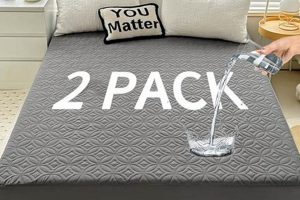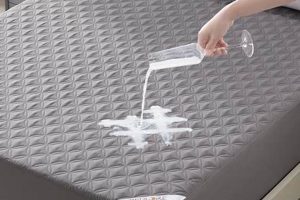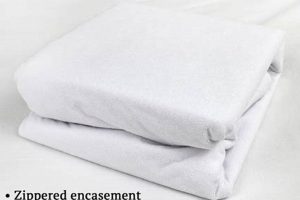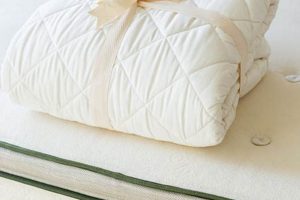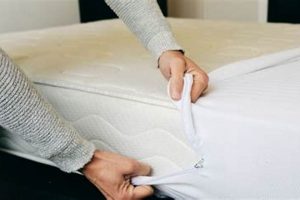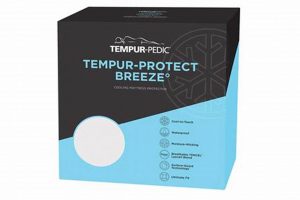The question of whether a mattress protector is launderable is a common inquiry concerning bedding maintenance. The answer largely depends on the specific materials and construction of the protector. Many protectors are designed for machine washing, utilizing fabrics like cotton, polyester, or blends that can withstand regular laundering. Protectors incorporating waterproof membranes, such as polyurethane, also often allow for washing, although specific care instructions should be followed diligently.
Maintaining a clean mattress protector is paramount for hygiene and extending the lifespan of both the protector and the mattress it covers. Regular washing helps to remove allergens, dust mites, and body fluids, creating a healthier sleep environment. Furthermore, prompt cleaning of spills or stains prevents permanent damage and unpleasant odors. The practice of using and cleaning these protective layers has evolved alongside advancements in textile technology, offering consumers increasingly convenient and effective solutions for mattress care.
Understanding the recommended washing procedures is essential. This includes considering the appropriate water temperature, detergent type, and drying method. Following manufacturer guidelines is critical to preserving the integrity and functionality of the protector. Overlooking these instructions can lead to shrinkage, delamination of waterproof layers, or other forms of damage. The following sections will detail the recommended washing practices and related considerations.
Guidance on Maintaining a Launderable Mattress Protector
The following guidelines are crucial for ensuring the longevity and effectiveness of a mattress protector designed for washing. Adherence to these tips will optimize cleanliness and safeguard the protective qualities of the bedding item.
Tip 1: Consult the Care Label: Prior to any washing attempt, meticulously review the manufacturer’s care label. This label provides specific instructions regarding water temperature, detergent type, and drying methods. Ignoring these instructions can result in irreversible damage.
Tip 2: Utilize Gentle Detergents: Harsh chemicals can compromise the integrity of the protector’s materials, particularly waterproof membranes. Employ a mild, hypoallergenic detergent to prevent degradation and minimize the risk of allergic reactions.
Tip 3: Employ Cold or Warm Water: High water temperatures may cause shrinkage or warping. Unless explicitly specified on the care label, opt for cold or warm water settings to preserve the protector’s shape and fit.
Tip 4: Avoid Fabric Softeners and Bleach: Fabric softeners can leave residue that diminishes the protector’s breathability and waterproof capabilities. Bleach, even in diluted forms, can weaken fibers and cause discoloration. These products should be strictly avoided.
Tip 5: Tumble Dry on Low Heat: Excessive heat can damage waterproof layers and cause the protector to lose its shape. Tumble drying on a low heat setting, or air drying, is recommended to prevent these issues.
Tip 6: Ensure Complete Dryness: Before placing the protector back on the mattress, verify that it is completely dry. Dampness can foster mold and mildew growth, compromising hygiene and potentially damaging the mattress.
Tip 7: Wash Regularly: Establish a consistent washing schedule, typically every one to two months, to maintain optimal hygiene and remove allergens. More frequent washing may be necessary in cases of spills or heavy soiling.
Diligent adherence to these guidelines will significantly extend the lifespan of the mattress protector and ensure its continued effectiveness in safeguarding the mattress. These practices promote a healthier sleep environment and contribute to the overall longevity of the bedding.
The next section will address common problems encountered when laundering mattress protectors and their respective solutions.
1. Material Composition
The composition of a mattress protector is the primary determinant of its launderability and the appropriate washing methods. The textiles and materials used directly impact its resistance to damage during the washing and drying processes. Understanding the composition is essential for effective care and maintenance.
- Cotton and Cotton Blends
Cotton and cotton blends are common materials in mattress protectors due to their breathability and comfort. These materials generally withstand machine washing well. However, the specific blend ratio (e.g., cotton-polyester) can influence shrinkage. Higher cotton content may lead to more shrinkage compared to blends with a larger proportion of synthetic fibers. Therefore, following care label instructions regarding water temperature and drying methods is critical to minimize potential alterations in size and shape.
- Polyester and Synthetic Fabrics
Polyester and other synthetic fabrics offer durability and resistance to shrinking and wrinkling. They are often incorporated into mattress protectors to enhance their lifespan and ease of care. While generally machine washable, synthetic materials can be more susceptible to damage from high heat. High-temperature washing or drying may cause melting or distortion of the fibers, compromising the protector’s structural integrity and performance. Adhering to low-heat or air-drying recommendations is crucial for these materials.
- Waterproof Membranes (Polyurethane, TPU)
Many mattress protectors feature a waterproof membrane to prevent liquids from penetrating the mattress. These membranes are typically made of polyurethane or TPU (thermoplastic polyurethane). While designed to be waterproof, these materials can be delicate and prone to damage from harsh detergents or high heat. Excessive heat can cause the membrane to delaminate or crack, rendering it ineffective. It is generally recommended to use gentle detergents and tumble dry on low heat, or preferably air dry, to preserve the membrane’s integrity and waterproof qualities. Some protectors may even require hand washing to extend its lifespan.
- Specialty Fabrics (Bamboo, Tencel)
Certain mattress protectors utilize specialty fabrics such as bamboo or Tencel (lyocell) for enhanced comfort and moisture-wicking properties. These materials are often derived from natural sources and may require specific care considerations. Although typically machine washable, they can be more susceptible to shrinking or pilling if not handled correctly. Cold water washing and gentle drying cycles are often recommended to maintain the fabric’s texture and prevent damage. Reviewing the care label for guidance specific to these fabrics is essential to ensure proper maintenance.
In summary, the material composition of a mattress protector directly dictates its washability and appropriate care procedures. Understanding the properties and limitations of each material typewhether cotton, polyester, waterproof membranes, or specialty fabricsis crucial for preserving its condition and ensuring continued protection of the mattress. Prioritizing adherence to the manufacturer’s care label remains the most reliable approach to optimizing both hygiene and longevity.
2. Care Label Instructions
The feasibility of laundering a mattress protector is inextricably linked to the instructions provided on its care label. These instructions, established by the manufacturer, serve as the definitive guide for proper cleaning and maintenance. Deviation from these guidelines can result in damage to the protector, rendering it less effective or unusable. The care label specifies critical parameters such as permissible water temperature, suitable detergent types, and appropriate drying methods. For example, a protector with a polyurethane waterproof membrane may require cold water washing and low-heat drying to prevent delamination. Failure to adhere to these specific instructions would likely compromise the membrane’s integrity, diminishing its waterproofing capabilities.
The importance of the care label extends beyond preventing immediate damage. Consistent adherence to these instructions contributes to the long-term preservation of the protector’s functional properties. Repeated washing under conditions exceeding the manufacturer’s recommendations can weaken the fabric, degrade waterproof layers, and reduce overall protection. Consider a protector made with a blend of cotton and polyester. The care label might advise against using bleach, as it can weaken the cotton fibers over time. Ignoring this instruction could lead to premature wear and tear, necessitating earlier replacement of the protector. Thus, the care label serves as a critical tool for maximizing the lifespan and effectiveness of the product.
In summary, the care label represents the single most important resource in determining whether and how a mattress protector may be safely and effectively washed. Disregarding these instructions carries significant risk, potentially leading to irreversible damage and reduced functionality. By carefully reviewing and diligently following the recommendations outlined on the care label, individuals can ensure the continued hygiene and protective capacity of their mattress protector, thereby prolonging its lifespan and maintaining a healthier sleep environment. The absence of a care label or illegible instructions presents a significant challenge, potentially requiring contacting the manufacturer directly for guidance.
3. Washing Frequency
The frequency with which a mattress protector undergoes laundering is a critical factor directly impacting its overall cleanliness, hygiene, and longevity. The answer to “can mattress protector be washed” is often affirmative, but the how often is a related, and important question. Balancing the need for sanitation with the potential for wear and tear requires careful consideration.
- Regular Allergen Removal
Consistent washing schedules, generally every one to two months, serve to eliminate accumulated allergens, dust mites, and skin cells. Individuals with allergies or asthma benefit significantly from this practice. Infrequent washing allows these irritants to build up, potentially exacerbating respiratory issues and compromising sleep quality. Conversely, excessive washing, while seemingly beneficial, can degrade the protector’s materials over time, reducing its effectiveness.
- Spill and Stain Management
Prompt laundering is essential following any spills or stains. Delaying this process allows substances to penetrate the protector’s layers, potentially causing permanent discoloration or fostering microbial growth. The type of spill also influences the urgency and method of washing. For example, blood or bodily fluids require immediate attention and may necessitate the use of specific stain removal techniques, while minor spills might be addressed with spot cleaning before a full wash.
- Material Degradation Considerations
Each wash cycle subjects the protector to mechanical stress, detergent exposure, and temperature fluctuations, all of which contribute to gradual material degradation. Waterproof membranes, in particular, are vulnerable to damage from excessive washing, potentially losing their impermeability. Balancing the need for cleanliness with the desire to preserve the protector’s integrity requires adhering to the manufacturer’s care instructions regarding washing frequency and methods.
- Environmental Impact
Frequent washing contributes to water and energy consumption, as well as the release of detergent chemicals into the environment. Optimizing the washing frequency to the minimum necessary for maintaining hygiene and cleanliness can mitigate these environmental impacts. Utilizing eco-friendly detergents and energy-efficient washing machines further reduces the carbon footprint associated with laundering mattress protectors.
These facets highlight the complex interplay between hygiene, material longevity, and environmental responsibility when determining an appropriate washing frequency. While most mattress protectors “can be washed,” the optimal frequency is a balance dictated by individual needs, environmental considerations, and adherence to manufacturer guidelines. Over washing should be avoid because it can reduce lifespan.
4. Detergent Selection
The effectiveness and longevity of a mattress protector that “can be washed” are significantly influenced by the detergent employed. Detergent selection is not merely a peripheral consideration; it is an integral component of proper maintenance. Inappropriate detergents can compromise the integrity of the protector’s materials, diminishing its protective qualities and shortening its lifespan. For example, harsh chemicals present in some conventional detergents can degrade waterproof membranes, rendering them ineffective in preventing liquid penetration. This direct cause-and-effect relationship underscores the importance of informed detergent selection when addressing the washability of mattress protectors.
Consider a scenario where a mattress protector with a polyurethane waterproof layer is routinely washed with a detergent containing bleach. Over time, the bleach will weaken the polyurethane, causing it to crack and lose its waterproof properties. The protector, initially designed to safeguard the mattress from spills and stains, now becomes permeable, defeating its primary purpose. Conversely, utilizing a mild, hypoallergenic detergent specifically formulated for delicate fabrics will preserve the membrane’s integrity, ensuring continued protection and extending the protector’s usable life. This demonstrates the practical significance of understanding the interplay between detergent composition and material compatibility.
In conclusion, while a mattress protector may be inherently washable, the choice of detergent plays a crucial role in ensuring its continued functionality. Opting for gentle, hypoallergenic formulations free from harsh chemicals and bleaching agents is paramount. Challenges may arise in identifying suitable detergents, particularly with the proliferation of products claiming eco-friendliness or specialized cleaning capabilities. Ultimately, careful review of detergent ingredients and adherence to the mattress protector’s care label are essential for optimizing cleaning effectiveness while safeguarding the product’s longevity.
5. Drying Method
The viability of laundering a mattress protector is intrinsically linked to the subsequent drying method employed. A protector that “can be washed” can nevertheless be rendered unusable if dried improperly. The drying method is not simply a follow-up step; it is a crucial component of the entire cleaning process, directly affecting the protector’s structure and functionality. For instance, a mattress protector containing a waterproof membrane may be machine washable, but high-heat drying can cause the membrane to delaminate or crack, thereby compromising its ability to protect the mattress from liquids. The cause-and-effect relationship here is evident: improper drying negates the benefits of washing.
Practical applications of this understanding are manifold. Care labels typically specify the recommended drying method, often indicating “tumble dry low” or “line dry.” Adherence to these instructions is paramount. Consider a scenario where a protector made of a cotton-polyester blend is washed and then subjected to high-heat drying. The cotton fibers may shrink, while the polyester fibers remain relatively unchanged, leading to distortion of the protector’s shape and fit. This outcome undermines the protector’s ability to properly encase the mattress, reducing its effectiveness. Conversely, selecting a low-heat or air-drying method allows the materials to dry evenly, minimizing the risk of shrinkage and maintaining the protector’s intended dimensions and protective qualities. The drying method employed is thus a critical determinant of the protector’s post-wash performance.
In summary, while the washability of a mattress protector is a primary consideration, the choice of drying method is equally important. Improper drying can negate the benefits of washing, leading to damage and reduced functionality. Careful attention to the manufacturer’s drying instructions, typically found on the care label, is essential for preserving the integrity of the protector and ensuring its continued effectiveness. Challenges may arise when dealing with protectors lacking clear care instructions, necessitating cautious experimentation or contacting the manufacturer for guidance. Ultimately, a comprehensive understanding of both washing and drying methods is crucial for maintaining a clean and functional mattress protector.
Frequently Asked Questions
The following questions and answers address common concerns regarding the washing of mattress protectors, providing clarity and guidance for optimal care and maintenance.
Question 1: Is every mattress protector designed to be machine-washed?
No. The ability to machine-wash a mattress protector depends on its materials and construction. Protectors with delicate waterproof membranes or specialty fabrics may require hand-washing or spot-cleaning to prevent damage.
Question 2: What is the recommended water temperature for washing a mattress protector?
The appropriate water temperature varies based on the protector’s care label. Generally, cold or warm water is recommended to prevent shrinkage or damage to waterproof layers. High water temperatures are generally discouraged.
Question 3: Are specific detergents necessary for washing mattress protectors?
Yes. Harsh chemicals or bleaching agents can degrade the protector’s materials. A mild, hypoallergenic detergent is recommended to maintain the protector’s integrity and prevent allergic reactions.
Question 4: Can fabric softeners be used when washing a mattress protector?
Fabric softeners are generally not recommended. They can leave residue that diminishes the protector’s breathability and waterproof capabilities, potentially compromising its function.
Question 5: What is the best method for drying a mattress protector after washing?
Tumble drying on low heat or air drying is generally recommended. High heat can damage waterproof membranes and cause shrinkage. Thorough drying is crucial to prevent mold and mildew growth.
Question 6: How frequently should a mattress protector be washed?
A washing schedule of every one to two months is generally recommended for routine hygiene. More frequent washing may be necessary in cases of spills or heavy soiling. Always consider manufacturer instructions first.
In summary, proper washing practices significantly contribute to maintaining a clean and functional mattress protector. Adherence to manufacturer instructions regarding water temperature, detergent selection, and drying method is paramount.
The subsequent section will provide guidance on extending the lifespan of a mattress protector, offering actionable tips for long-term care and maintenance.
Considerations Regarding Mattress Protector Launderability
This examination has detailed the conditions under which a mattress protector “can be washed,” emphasizing the critical interplay between material composition, care label instructions, washing frequency, detergent selection, and drying method. Each element contributes to the protector’s lifespan and its continued effectiveness in safeguarding the mattress. Deviation from recommended practices can lead to diminished performance or irreversible damage.
The responsibility for proper maintenance rests with the consumer. Adherence to manufacturer guidelines and diligent cleaning practices are essential for maximizing the protector’s hygienic benefits and prolonging its service life. A well-maintained mattress protector is not merely a matter of cleanliness, but a direct investment in the longevity and health of the sleep environment.


